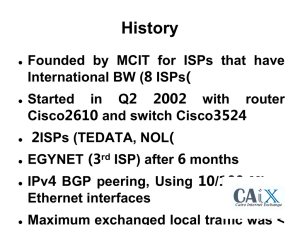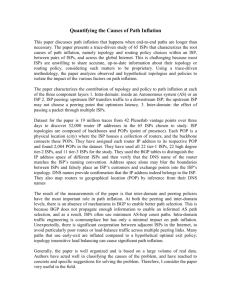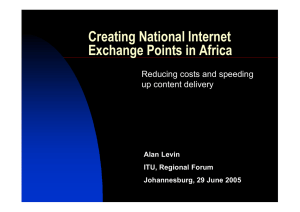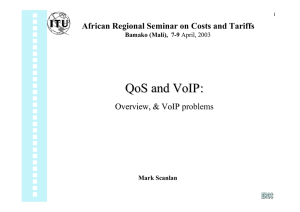Economic Viability of Internet Introduction
advertisement
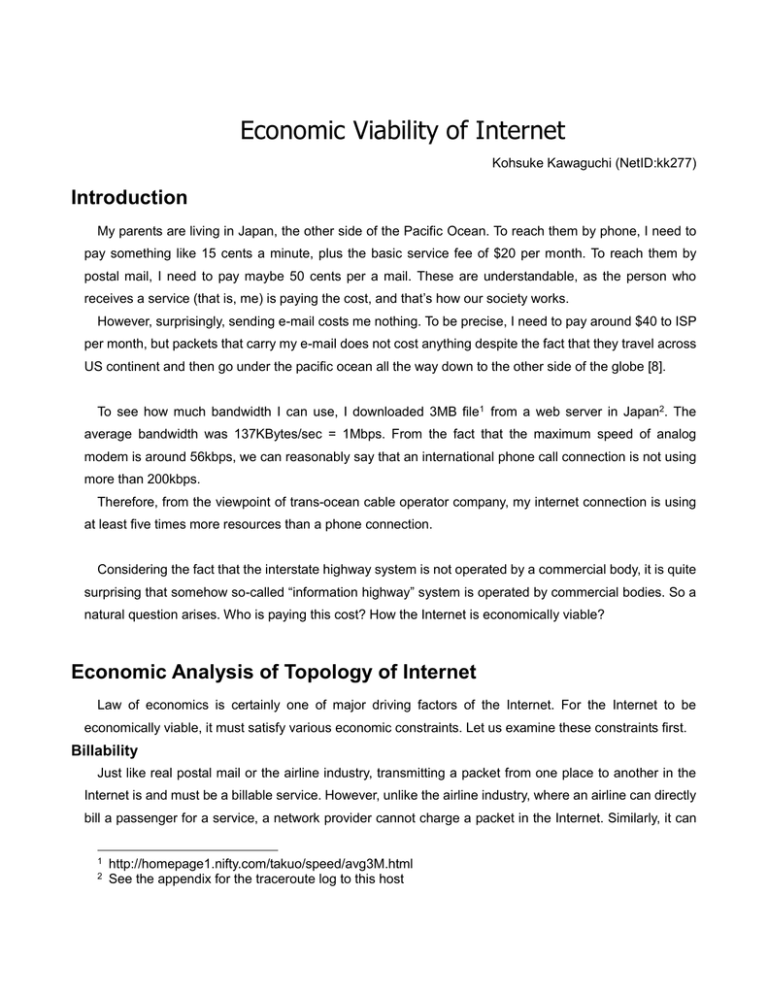
Economic Viability of Internet Kohsuke Kawaguchi (NetID:kk277) Introduction My parents are living in Japan, the other side of the Pacific Ocean. To reach them by phone, I need to pay something like 15 cents a minute, plus the basic service fee of $20 per month. To reach them by postal mail, I need to pay maybe 50 cents per a mail. These are understandable, as the person who receives a service (that is, me) is paying the cost, and that’s how our society works. However, surprisingly, sending e-mail costs me nothing. To be precise, I need to pay around $40 to ISP per month, but packets that carry my e-mail does not cost anything despite the fact that they travel across US continent and then go under the pacific ocean all the way down to the other side of the globe [8]. To see how much bandwidth I can use, I downloaded 3MB file1 from a web server in Japan2. The average bandwidth was 137KBytes/sec = 1Mbps. From the fact that the maximum speed of analog modem is around 56kbps, we can reasonably say that an international phone call connection is not using more than 200kbps. Therefore, from the viewpoint of trans-ocean cable operator company, my internet connection is using at least five times more resources than a phone connection. Considering the fact that the interstate highway system is not operated by a commercial body, it is quite surprising that somehow so-called “information highway” system is operated by commercial bodies. So a natural question arises. Who is paying this cost? How the Internet is economically viable? Economic Analysis of Topology of Internet Law of economics is certainly one of major driving factors of the Internet. For the Internet to be economically viable, it must satisfy various economic constraints. Let us examine these constraints first. Billability Just like real postal mail or the airline industry, transmitting a packet from one place to another in the Internet is and must be a billable service. However, unlike the airline industry, where an airline can directly bill a passenger for a service, a network provider cannot charge a packet in the Internet. Similarly, it can 1 2 http://homepage1.nifty.com/takuo/speed/avg3M.html See the appendix for the traceroute log to this host charge neither the sender nor the receiver, because it only knows them by their IP addresses. Therefore, for the Internet to be economically viable, it must be possible for any network provider to find an entity to bill. Let us call this constraint the billability constraint. Orientability In case of the airline industry, it is obvious what is the service and therefore who needs to pay whom. However, in the Internet, this is not so clear. Assume two autonomous systems (AS) A and B, and consider a packet from A to B. What is the service in this picture? One can argue that A, the sender, is offering a service of sending data that B wants to receive. Similarly, one can argue that B, the receiver, is offering a service of delivering data to its final destination on behalf of A. With unclear definition of a service, it is difficult to determine which direction shall money go. Therefore, for the Internet to be economically feasible, it must be possible to “orient” this relationship to determine the direction of money. Let us call this constraint the orientability constraint. Incentive Finally, for an economic activity to happen by one’s free will, it must be possible to gain profit from such activities. For otherwise such a service will not be provided. Under the light of these constraints, we can say that, for instance, the Internet cannot be a flat graph of inter-connected routers 3 because this scheme does not satisfy the billability constraint (how an intermediate router charges the cost of its services?). By having all three constraints satisfied, a new kind of AS emerges. What’s interesting with this new kind of AS is that its sole purpose of being an AS is to gain profit from it. In this paper, we use the word ISP to denote this kind of AS. Then what kind of connections can be possible under these constraints? Let us examine common types of connections among ISPs [5,9]. Transit Connection Just like I subscribe to an ISP to access the Internet, an ISP can use another upstream ISP to “access” the Internet. Unlike residential customers, it is common for ISPs to use more than one upstream ISP for 3 This model is the model that was experimented in the class --- a mob of routers (students) connected to nearby routers. various reasons4 [6]. This kind of connections is called “transit connection”, since the upstream ISP is providing a transit service for downstream ISPs. This satisfies the billability constraint. An upstream ISP can bill the downstream ISP, either metered5 or by a fixed price, since the upstream ISP can spot a physical line that connects itself to a downstream ISP and easily monitor the amount of data goes through that line. This satisfies the orientability constraint as well, as it is the upstream ISP who provides the service of connecting downstream ISPs to the Internet. So not surprisingly, downstream ISPs pay some money for the upstream ISP. Finally, the incentive constraint is satisfied, because an ISP can charge downstream more then its upstream ISP charges it. Private Peering Another very common type of a connection between ISPs is called “private peering”. You can think of private peering as an equal-terms relationship between two ISPs. Two ISPs connect themselves each other directly, and a packet that goes from one ISP to the other is routed through this connection. Note that the only distinction between the transit connection and the private peering is the relationship of the participants. If one party starts to accept packets that go to other networks, it is a transit service and therefore no longer called a private peering. This satisfies the orientability constraint, since two parties are equal. The billability constraint is also satisfied, as there is no need for billing. With this peer connection, they can reduce traffic that goes through upstream ISP, which costs money. Thus there is economic incentive to engage in private peering as well. IX/NAP Internet Exchange (IX) or Network Access Point (NAP)6 is a sophisticated version of the private peering. Imagine the trading of commodities. It starts with a peer-to-peer exchange, but soon a market is formed, because operational cost of using a market is cheaper than having n2 peer-to-peer exchanges[3]. The same force drives private peering to IX: IX and NAP are markets where data are exchanged. 4 For instance, One of the upstream ASs of Road Runner is ATOL Transit Data Network (atdn.net) Though a technical reason makes metered charge difficult and uncommon. 6 The name “NAP” is misleading, because it is by no means an access point, even though historically it was. 5 Just like NYSE charges its participants (like Merrill Lynch or JP Morgan), IX charges their participant ASs for the service of providing a market. The billability constraint is satisfied, as an IX can control who can join the market (they usually charge a fixed price based on the bandwidth, probably because of the technical difficulty of metering traffic). The orientability constraint is also satisfied since it is the IX who is providing a service. Economic incentive also exists for participants, as typically this is cheaper than setting up many individual private peering with other ASs. Note that economics govern the relationship between two participants as well. So any two participants of IX must engage in some sort of relationship (either transit or peering) Interestingly, existing IXs seem to support only private peering relationships among participants7, and not hierarchical ones, though the law of economics does not prevent this from happen8. Internet Atlas These three connection types among ASs form the current Internet. So economically more accurate conceptual view of the Internet would be as follows. First, start by the transit connections. The tree structure guarantees that there is at least one route that obeys the law of economics to get to any destination. In this sense this is true backbone of the Internet [7] with no redundancy. Since there is no root network, this forms a forest. Those top-most ISPs are called “tier-1 ISPs”. Those ISPs that are directly connected to a tier-1 ISP is called “tier-2 ISPs”, and so on. This tree structure affects the way other types of connections work. 7 8 Thus usually ISPs or similar size gathers at one IX. I suppose this is mainly because of the technical reason. To charge traffic from a router A to another router B, IX must keep track of data that goes from A to B. It is difficult to meter such packets from the network. ISP can use more than one upstream ISP [6]. By adding such edges, we get: Although this no longer looks like a forest, it still retains the hierarchical structure, which is a necessary consequence from the economical point of view. By further adding private peering lines by dash lines, we get: Where private peering connections are dense, there are IXs. By adding boxes that represent IXs, finally the shape of the Internet is like this: Observations Here are a couple of my observations about the topology of the Internet with respect to economics. Densely Inter-connected Tier-2 ISPs With a help of my friend in Japan, I conducted a little experiment of running traceroute to various places around the world (Cairo University in Egypt 9 , another university in Switzerland 10 , and Argentina government11.) In all cases, it turns out those packets only went as high as tier-2 network, and we couldn’t find a destination that can be reached only through a tier-1 backbone that provides transit service between IXs. A packet crossed Pacific ocean through the network of IIJ[1], then went directly to other ISP through one of major IXs, such as MAE-WEST. For a packet to be routed through a tier-1 backbone, it must be the case that two tier-2 networks are not directly connected to each other. However, it seems that large-scale IXs are so small in number [4] that it is difficult for two major carriers not to have any IX in common. This can be one economic explanation of why the Internet is connected in such a US-centric way. Assume that I started a company that operates an IX in Thailand, hoping to attract various Asia-Oceania ISPs. This company will not do very well, because there is less economic incentive for regional ISPs to join such IX. For instance, a Japanese ISP only need to join one of major IXs in US and it can exchange traffic with Australian ISP. Maintaining 2Gbps trans-pacific cable(TPC) is cheaper than maintaining 1Gbps TPC and another 1Gbps Japan-Australia cable. Hence there is less need to exchange traffic at Thailand [2]. As more and more traffic goes through US, US attracts more services like web hosting, since US is “closer” to users around the world. Those sites attract more traffic to US, and it goes on. So this forms a cycle, which discourages a new non-US IX from entering a market. Lost Business Opportunity Consider three tier-2 ISPs A,B, and C. Assume A and B are connected through IX or private peering, B and C are connected in a similar way, but tier-1 A and C are not connected. For A to route a packet to C, it must goes through tier-1 backbone, as private peering does not accept transit A B 9 C http://www.cairo.eun.eg/ www.unige.ch 11 www.presidencia.gov.ar 10 packets. With this situation, one can argue that B is losing a business opportunity, since B can offer a transit service from A to C by utilizing idle resources and charge A and C for this service, just like the tier-1 backbone does. I suppose the only reason why this doesn’t happen today is a technical reason that it is difficult to identify transit packets among others and charge them. But where sufficient economic incentive exists, a technology will emerge. It might be interesting to see if typical tier-2 ISPs have such idle bandwidth that can be allocated for this purpose. References 1. “IIJ Backbone” by IIJ (IIJ is one of major Japanese ISP. Written in Japanese) http://www.iij.ad.jp/network/backbone.html 2. “Address delegations for MAE-ATM West” by WorldCom http://www.mae.net/ATM/west-addr.htm 3. “Dictionary of Digital Terms” by ASCII Corporation (written in Japanese) http://yougo.ascii24.com/gh/77/007774.html 4. “The Internet Exchange Points Directory” by TeleGeography http://www.telegeography.com/pubs/db/ix/index.html 5. “Report on Opening a new IX in Kansai district” by Ministry of Economy, Trade, and Industry, Japanese government (written in Japanese) http://www.kansai.meti.go.jp/5jousei/ix/iti.pdf 6. “OCN Backbone connection map” by NTT Communications (OCN is another Japanese domestic network carrier. Map contains Japanese characters) http://www.ocn.ne.jp/info/tech/images/backbone.gif 7. “Internet Service Providers | ComputerWorld Communities” by Patrick Thibodeau http://www.computerworld.com/cwi/community/story/0,3201,NAV65-663_STO43538,00.html 8. “Exploring Infrastructure” by Naomi Suzuki (written in Japanese) http://www.watch.impress.co.jp/broadband/column/infra/2001/10/04/ 9. “Internet Operation” by Jun Murai (written in Japanese) http://www.soi.wide.ad.jp/class/20010011/materials_for_student/09/operation1210.pdf

